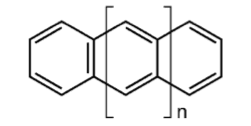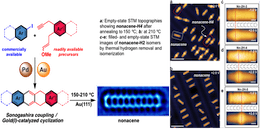Polyacenes constitute a class of organic compounds composed by adjacent fused benzene rings. These compounds  exhibit interesting electronic properties due to their high degree of conjugation which allows electrons to flow across the molecule. The high charge carrier mobility of these materials is used frequently in organic field-effect transistors and optoelectronic applications. Most commonly used acenes are tetracene (n=2) and pentacene (n=3). While longer linear acenes are expected to exhibit improved properties, their preparation has however proved highly challenging due to the instability of the formed products. The research Group of Prof. A. Echavarren at ICIQ has recently developed a new strategy for the preparation of long linear polyacenes based on the on-surface dehydrogenation of a partially saturated linear polyacene compound readily accessible through available raw materials and transition metal catalysis (gold and palladium mediated processes). As illustrated below, the group successfully reported the first preparation of nonacene (n=7) from readily available precursors.
exhibit interesting electronic properties due to their high degree of conjugation which allows electrons to flow across the molecule. The high charge carrier mobility of these materials is used frequently in organic field-effect transistors and optoelectronic applications. Most commonly used acenes are tetracene (n=2) and pentacene (n=3). While longer linear acenes are expected to exhibit improved properties, their preparation has however proved highly challenging due to the instability of the formed products. The research Group of Prof. A. Echavarren at ICIQ has recently developed a new strategy for the preparation of long linear polyacenes based on the on-surface dehydrogenation of a partially saturated linear polyacene compound readily accessible through available raw materials and transition metal catalysis (gold and palladium mediated processes). As illustrated below, the group successfully reported the first preparation of nonacene (n=7) from readily available precursors.
 The findings in the preparation of nonacene from a partially hydrogenated derivative allows the development of semiconducting devices incorporating this oligoacene compound that exhibits a very low band gap of 1.19 eV (if compared with 1.84 eV for pentacene, and 2.54 eV for tetracene). This differential feature paves the way for the development of more efficient organic electronic devices, such as diodes (OLEDs), transistors (OTFTs, OFETs), and organic photovoltaics (OPVs). This technology is currently patent-pending in the United States of America. The research team has recently been awarded a Proof of Concept grant from the European Research Council in order to develop longer acenes (n=11, 13) and progress in the commercialization of this technology.
The findings in the preparation of nonacene from a partially hydrogenated derivative allows the development of semiconducting devices incorporating this oligoacene compound that exhibits a very low band gap of 1.19 eV (if compared with 1.84 eV for pentacene, and 2.54 eV for tetracene). This differential feature paves the way for the development of more efficient organic electronic devices, such as diodes (OLEDs), transistors (OTFTs, OFETs), and organic photovoltaics (OPVs). This technology is currently patent-pending in the United States of America. The research team has recently been awarded a Proof of Concept grant from the European Research Council in order to develop longer acenes (n=11, 13) and progress in the commercialization of this technology.
The provision of shelf-stable and readily accessible precursors of oligoacene compounds along with a straightforward method for their conversion into the polyaromatic compound that exhibit particularly low energy band gap and enhanced charge carrier mobility (presumably), pave the way towards a faster development of more efficient organic electronic devices for a broad number of applications. Industrial partners are sought for the testing and joint development of the technology through R&D collaborations.
1- Dorel, R.; McGonigal, P.R.; Echavarren,A.M. Angew. Chem. Int. Ed. 2016, 55, 11120
2- Zuzak, R.; Dorel, R.; Krawiec, M.; Such, B.; Kolmer, M.; Szymonski, M.; Echavarren, A.M.; Godlewsk, S. ACS Nano 2017, 9321-9329
3- Zuzak, R.; Dorel, R.; Kolmer, M.; Szymonski, M.; Godlewski, S.; Echavarren, A. M. Angew. Chem. Int. Ed. 2018, 57, 10500–10505.